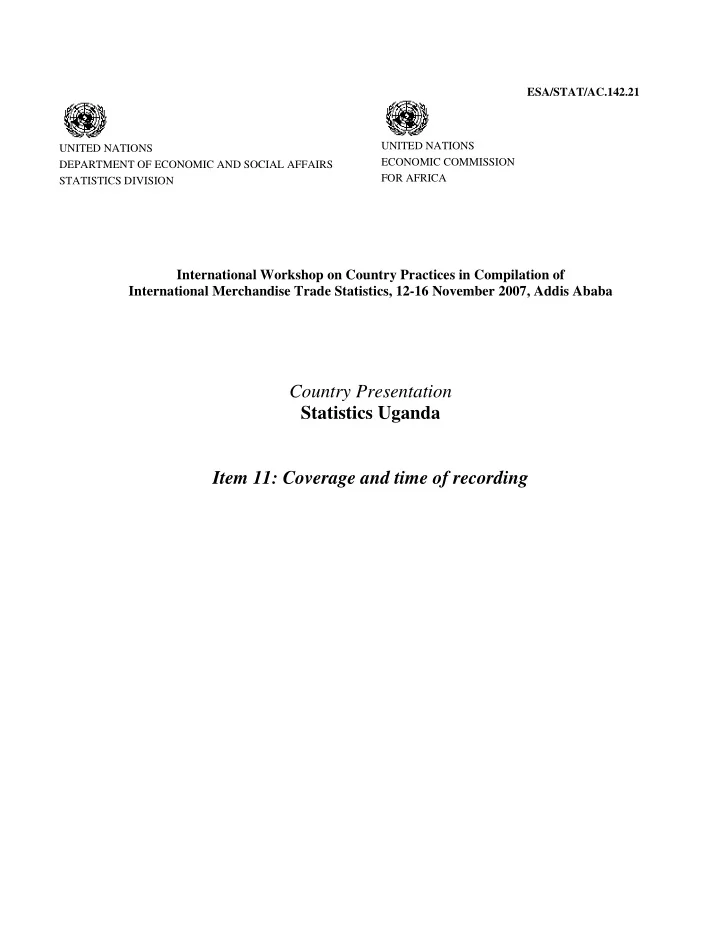

ESA/STAT/AC.142.21 UNITED NATIONS UNITED NATIONS ECONOMIC COMMISSION DEPARTMENT OF ECONOMIC AND SOCIAL AFFAIRS FOR AFRICA STATISTICS DIVISION International Workshop on Country Practices in Compilation of International Merchandise Trade Statistics, 12-16 November 2007, Addis Ababa Country Presentation Statistics Uganda Item 11: Coverage and time of recording
The Methodology for Collecting, Compiling and Integrating Informal/Unrecorded Cross Border Trade Data Presented at the UN Meeting Held on 12-16 th November 2007 in Addis Ababa, Ethiopia By John Mayende Senior Statistician Uganda Bureau Of Statistics 1 INTRODUCTION Uganda liberalized her Current and Capital Account in 1993 and 1997 respectively The trade sector was also freed, allowing the participation of both informal and formal traders in international trade. -The monopoly of commodity marketing boards was broken -Export duties were abolished The liberalized environment led to increased activities of informal cross border trade whose magnitude and contribution to overall international merchandise trade statistics remained unknown Informally traded goods were not recorded, hence leading to underestimation of economic statistics like International Merchandise Trade Statistics, BOP and GDP estimation. Three surveys have been conducted since 2003 to try to bridge this data gaps. 1
Institutional Arrangement The International Trade Statistics Committee (ITSC) is the overall coordinating body for ICBT survey in Uganda ITSC is composed of UBOS, URA, BOU, Ministries of Finance and Trade and Commodity Authorities -It identified the data gaps in IMTS -Sanctioned the execution of ICBT Survey ICBT Executing institutions *UBOS, BOU and URA Legal Framework *Statistics Act 1998, BOU Foreign Exchange Act 2004, URA Act 1991 Objectives of the Survey Overall Objective To establish the magnitude of unrecorded trade Specific objectives Determine the commodities transacted under ICBT Direction of trade (Destination/Origin) Flows in terms of values and quantities Provide a comparative analysis of recorded and unrecorded/net trade balances Determine the main beneficiary of ICBT activities Provide Monthly/Annual estimates for BOP/NAcs compilation 2
METHODOLOGY Selection of Border posts for monitoring Based on: *the volume of informal trade through the customs post *availability of supporting government institutions (URA,Police Etc) *Road network The border posts were purposively selected (representing 85%) Direct Observation method – Enumerators positioned strategically to monitor goods as they enter or leave the country – First Recording done in counter books – Daily transactions summarized in “Summary Form A” Note: 1. Enumerators/supervisors underwent training in quantification, and developed units of measure for different items plus a field instructions manual 2. Each customs station had a weighing balance for verifying quantity 3. Commodity prices are collected at borders on daily basis FOB) METHODOLOGY cont’d Up-rating of results – To Compare the magnitude of recorded with unrecorded trade – Estimate monthly flows (from to 2weeks to 4weeks) Up-rating Assumptions – The supply and demand of industrial and other products is constant. – The supply and demand of agricultural products fluctuate depending on the day of the week, the season; whether planting or harvesting season. – Informal trade through other routes in the vicinity was estimated to be between 5-30 % of the monitored sites This was based on quantitative monthly reports The Model can be seen in the report 3
METHODOLOGY cont’d Estimation of missing data for un-monitored months Done to fill the existing data gaps Estimation Techniques Linear interpolation and extrapolation techniques were used in attempting to estimate monthly flows that were missed out due to logistical constraints. See report for details Survey Limitations Not all customs stations were covered Two weeks were monitored instead of four in a month Direct observation method could not estimate accurately the quantities of assorted goods The vast stretch of the borders made it difficult for enumerators to monitor all exit and entry points. 4
ICBT Data Integration Data integration process Coding of commodities into HS 2002 nomenclature 1. Customs data is then merged with ICBT data into one file of IMTS 2. ICBT data has already been integrated into BOP goods account at 3. aggregate level Publication of ICBT Survey Findings ICBT Survey report • Statistical Abstract 2007 • To be published in External trade Statistics after completion of coding • Implications of ICBT Data Improved the overall Uganda export earnings 1. The Current Account Balance (CAB) improved significantly 2. 3. CAB/GDP improved Exports/GDP ratio increased 4. 5
Thank you for your attention 6
Recommend
More recommend